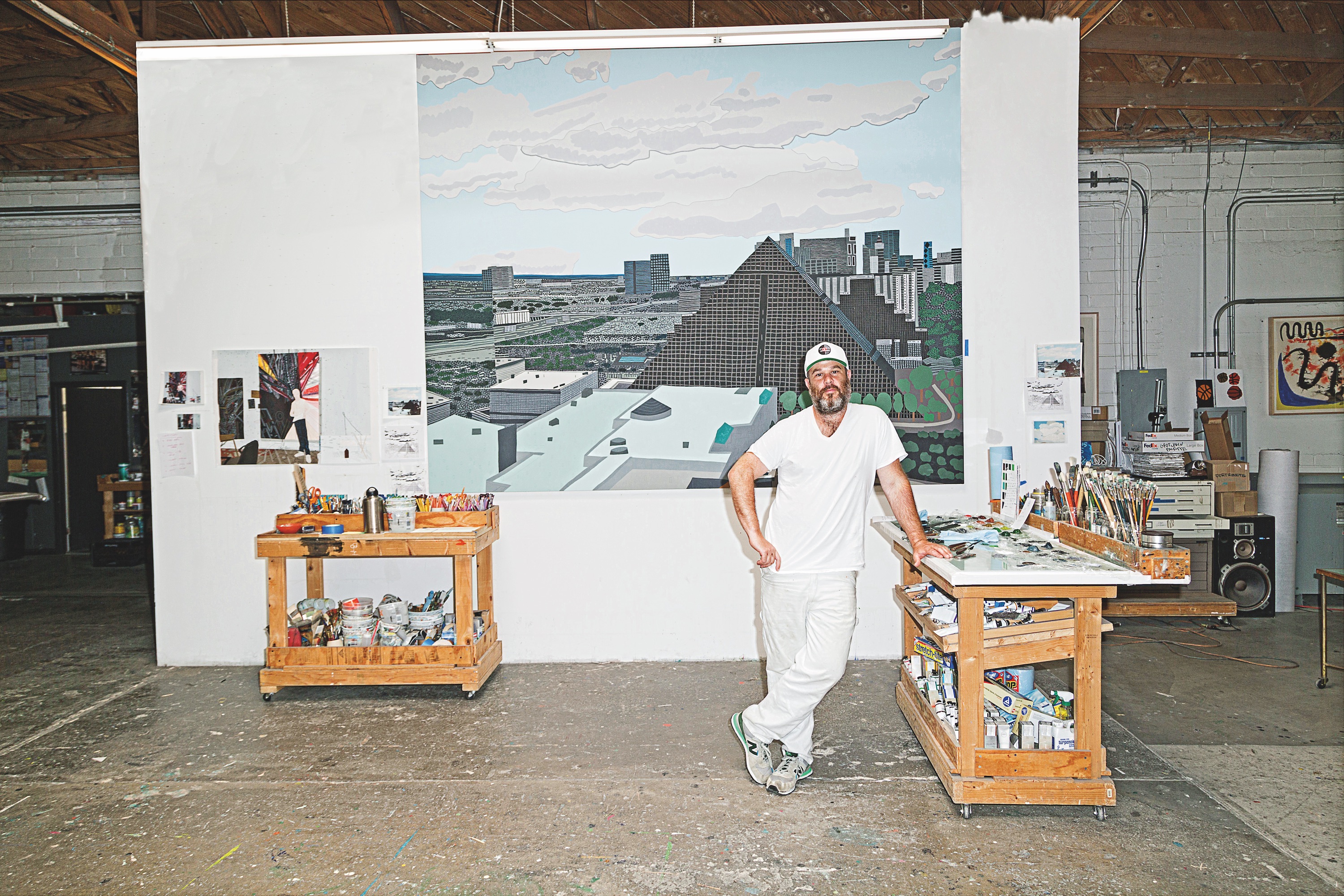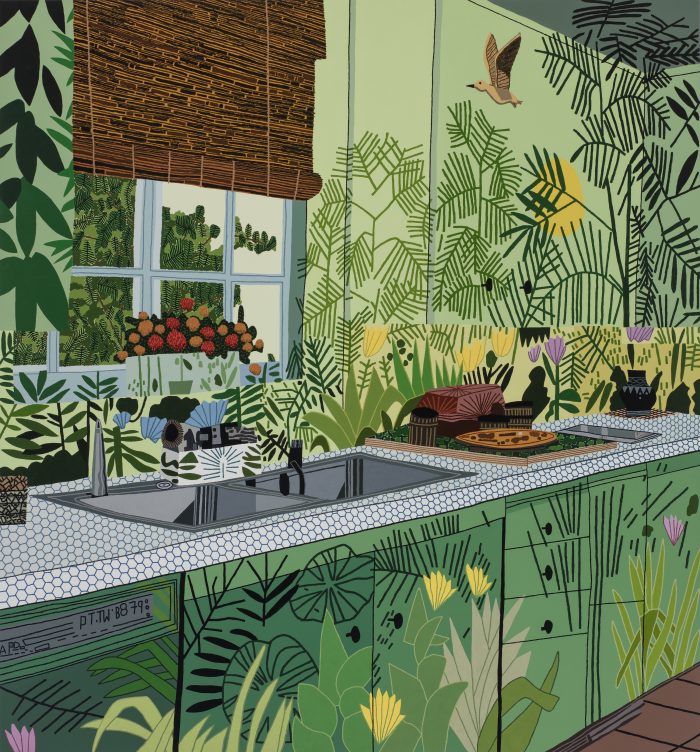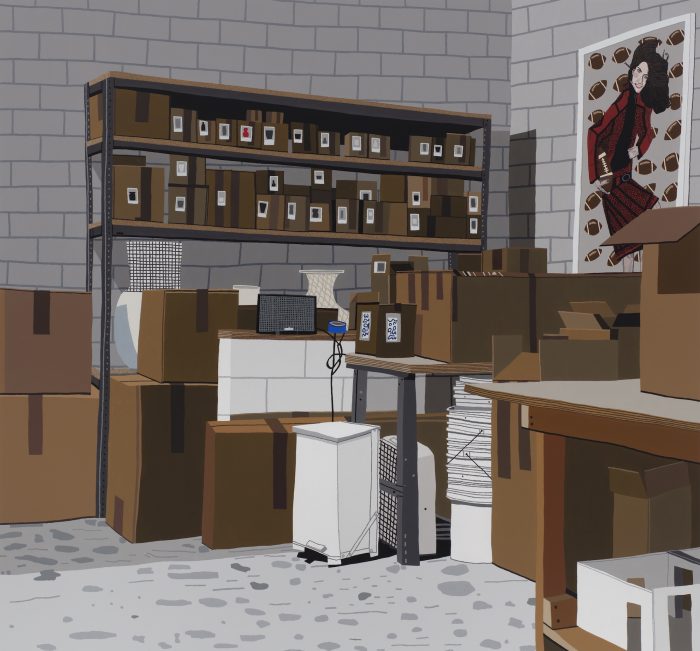
In the art world I thought I knew, no one would publicly admit to an interest in golf, least of all a young painter who was just making his name. But that is exactly what Jonas Wood did, a decade ago, when he made a painting of the golf course in Glendale where he was learning to play. Now, 10 years later, he is revisiting the subject in his latest show at David Kordansky Gallery, Los Angeles, which will take over both spaces (and viewing room) of the imposing gallery in November. It does not matter to Wood that the subject of these paintings is the squarest, most buttoned-up, bourgeois weekend pastime going.
“I don’t really think about that,” he tells me in his Culver City studio, one of three in the neighborhood that he and his wife, the ceramicist Shio Kusaka, share. “I don’t really care. I just think about, what am I interested in?”
Wood paints what he loves—or at least what he cares about—and he strives to make us care about it too. He has painted boxers and basketball players, his friends and family, his home and scenes from his childhood. His wife’s pots feature frequently; he and Kusaka have a joint exhibition at the new Museum Voorlinden in the Netherlands opening September 30. As his paintings get bigger (the biggest in the Kordansky show is ten feet tall), he says that if he is not “in love with that image and in love with that idea,” it is “really, really difficult” to maintain focus.

A recent painting, Head Up (2013), showed a televised poker tournament. “I paint paintings of poker players because I like to play poker,” Wood explains, deadpan. “And also because the images are super interesting.” Poker is a game not noted for its visual spectacle, but here the action (if one can call it that) unfolds against a hot pink carpet.
Wood’s big break in L.A. was partly down to poker. Arriving in the city in 2003, he worked as an assistant for the only artist he knew, the sculptor Matt Johnson, a classmate of Wood’s from high school in Massachusetts who was represented by Blum & Poe (and still is). Wood and Johnson regularly played poker with gallerist Jeff Poe and another gallery artist, the painter Mark Grotjahn. Wood became friendly with Grotjahn too after he bought one of Wood’s paintings from his first solo show at L.A. Black Dragon Society, in 2006. Grotjahn, who had not previously realized that Wood was an artist, introduced him to Anton Kern, his New York gallerist. Straightaway, Kern offered Wood an exhibition in summer 2007, which sold out.
Wood fast became known for paintings that were unaffected in their almost childlike charm, but also sophisticated in their adaptation of traditional genres and their witty take on appropriation. Alongside the golf course painting (Scholl Canyon, 2007) hung still lifes featuring potted plants from around Wood’s house and studio, and portraits of baseball and basketball players copied from trading cards. Guest Room (2007) depicted his childhood home, incorporating Wood’s versions of the portraits that hung on the walls.
Wood grew up around art. His grandfather, a pediatrician, began collecting after he became wealthy during the post-War baby boom, and also thanks to some early investments in IBM. Wood remembers being profoundly impressed by the works by Bacon, Rauschenberg, Motherwell and Lichtenstein he saw on his grandparents’ walls. A couple of these—a 1962 watercolor by Calder and a Rauschenberg print— now hang in Wood’s studio, alongside pieces from his own ever-growing collection.

“When I started showing, I started buying art,” Wood says. “I don’t really trade that often. I prefer to buy from someone’s show, because I know that it’s their best stuff. Trading is tough because I don’t just want some token thing, I want something good. And I have a hard time letting go of my own stuff.”
As soon as I walk through the door of his studio, Wood is showing me his collection, which includes a relief painting by Gina Beavers, a weaving by Christina Forrer, drawings by Joe Bradley, Laura Owens and Josh Smith, ceramics by Ry Rocklen, Patrick Jackson and Michael and Magdalena Suarez Frimkess. Often, pieces he owns wind up in his paintings—as, for example, with the decorated pots made by the Frimkesses, which he paints with imaginary plants growing out of them. Everything in Wood’s collection seems to relate somehow to his own work; when he shows me a landscape by Jake Longstreth featuring tennis courts beneath mountains, he comments that it’s almost like one of his own paintings of tennis courts.
Much has been written about the psychology of collecting, most of it not worth rehashing here. There nevertheless seems to be among many collectors a compulsion to simultaneously construct and possess an ideal world, of which they are at the center. All the best collections I’ve known have such a point of view—an approach that borders on artistic authorship even if the collector does not, in fact, call him or herself an artist.
Wood admits he is competitive, as one might expect from a sports fanatic. His inclination to return to previous subjects—to appropriate his own work—might be explained by his drive to improve. “I’m using these images as a vehicle for practicing painting,” he says. “I think of painting as an accumulation of practice. It’s technical. It’s scientific.
“I’m super competitive with myself, and with dead painters, and with a couple of living painters that I really like.” Like who? “I love Hockney, I love Alex Katz,” he replies. I suspect that there are others too, and that this competitiveness fires his acquisitive habit.
Posing for our photographer in a cap with a BBB logo, Wood narrates the backstory behind LaVar Ball’s line of Big Baller Brand merchandise, which capitalizes on the basketball careers of his three sons Lonzo, LiAngelo and LaMelo. Wood describes himself, self-deprecatingly, as “much more of a jock dude who likes to do non-art things, who just also happens to do art.” This is the impression that I (and, I suspect, many others) had on first encountering Wood at art events in L.A., who usually stood out as the only burly white guy in the room dressed in a basketball jersey. But for me— and, I’m certain, many others—the more that Wood reveals of himself through his work, the more that image becomes superseded by something more nuanced and surprising.

David Kordansky, who has worked with Wood since 2012, admits that he shared these initial impressions, but, “he totally upended my expectations, and the image I held in my head, of how an artist should look, talk, and be.” Kordansky calls him “one of the most sensitive, generous and loving people I know,” someone who “bridges worlds.”
Wood’s broad appeal will be acknowledged this month when he is honored at the TWO x TWO for AIDS and Art gala in Dallas. In an era in which bad news seems to flood our news feeds on an hourly basis, Wood’s paintings offer an escape from politics. “I feel like I’m adding something,” he says. “Like if you’re having a shitty day, maybe you could look at my painting and it would bring you some happiness.”










 in your life?
in your life?

